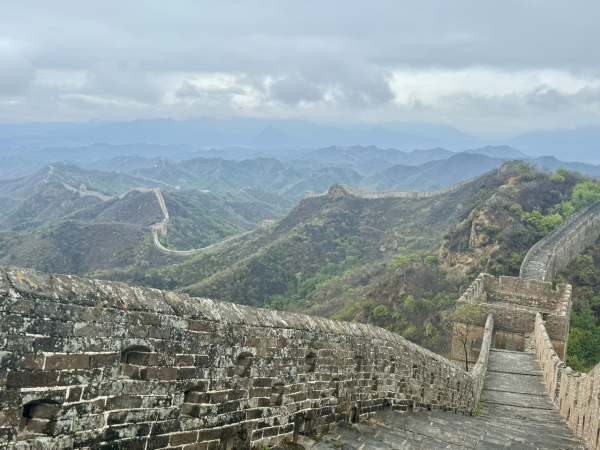
If you want to hike the Great Wall but don’t like organised tours, love the freedom of independent travel, hate overpaying for things you could easily arrange yourself, and want to experience the Wall without crowds and at your own pace, this article is for you. It’s a comprehensive guide to planning a 2-day hike on the Great Wall without joining a tour, in a budget-friendly, comfortable, and easy way.
Most online resources suggest that travelling to the Great Wall is expensive, complicated, and time-consuming because English isn’t widely spoken. While there is some truth to this, with today’s technology, it’s actually quite easy and affordable if you do a bit of research. And if you’re reading this blog post, you’re in luck, as I’ve already done the research and recently travelled to the Great Wall to check it out.
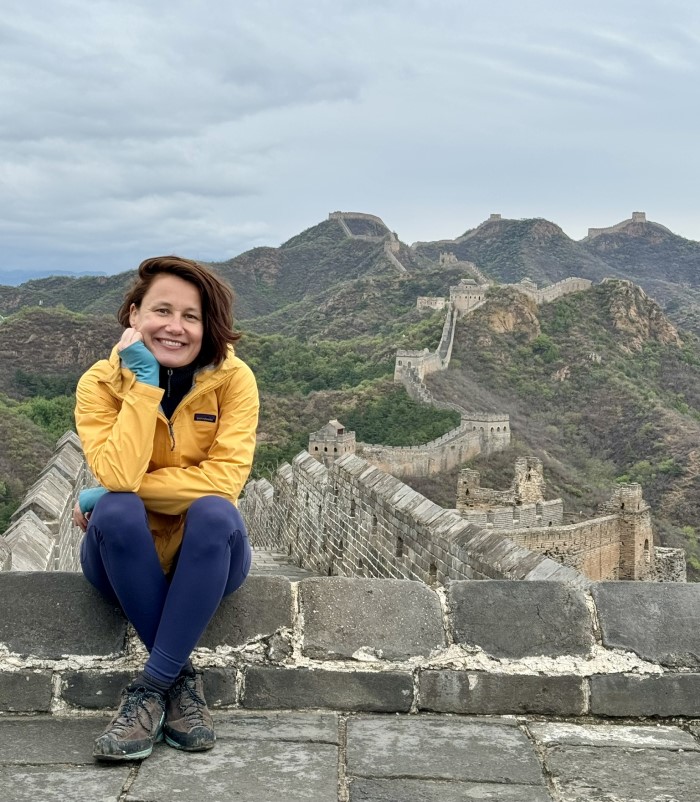
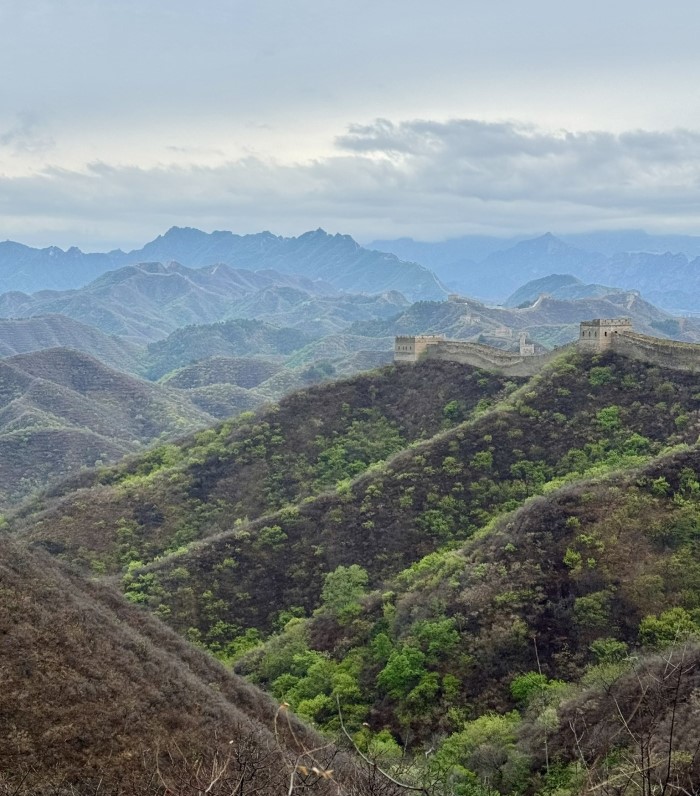
What's in this blog post?
> To avoid crowds on the Great Wall, head to Jinshanling
The best-preserved and most-visited parts of the Great Wall are about 130 km north of Beijing. Among them, Badaling and Mutianyu are the closest, just 70 km from the city, making them extremely popular and crowded. In particular, the Badaling section of the Great Wall, which has a daily visitor limit of 65,000 people, can be very packed!
If you want to hike the Great Wall without the crowds and have a more in-depth 2-day adventure, walking both restored and unrestored sections, head to the Jinshanling Great Wall, located further from Beijing (130 km). It’s really worth it.

The western section of the Great Wall, stretching from Jinshanling to Gubeikou, has never been reconstructed, while the eastern section from Jinshanling to Jinshanling East (also known as Simatai West) has been restored. Visiting both sides of the Great Wall and spending the night in Jinshanling will allow you to fully appreciate and enjoy the Great Wall more comfortably over 2 full days.
Gubeikou unrestored section vs. Jinshanling restored part
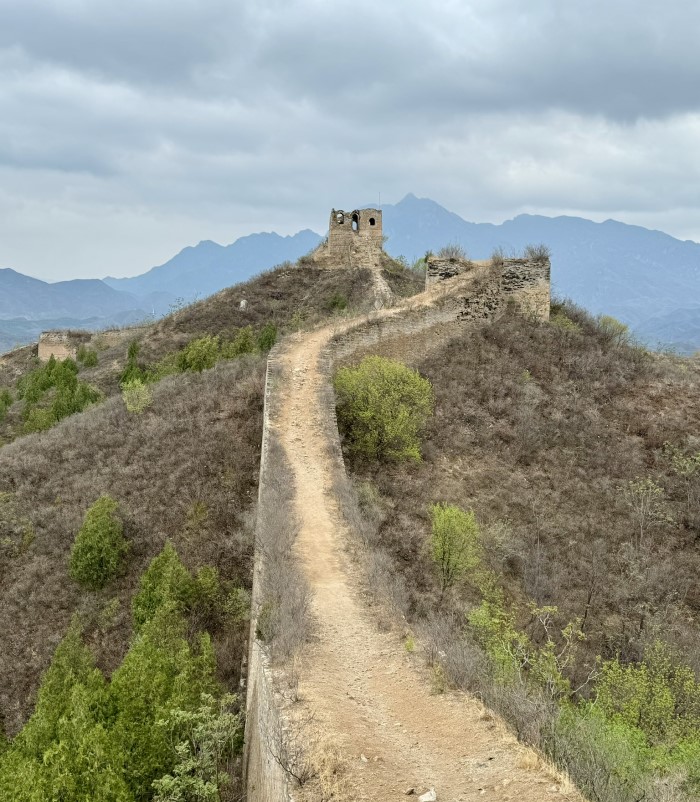
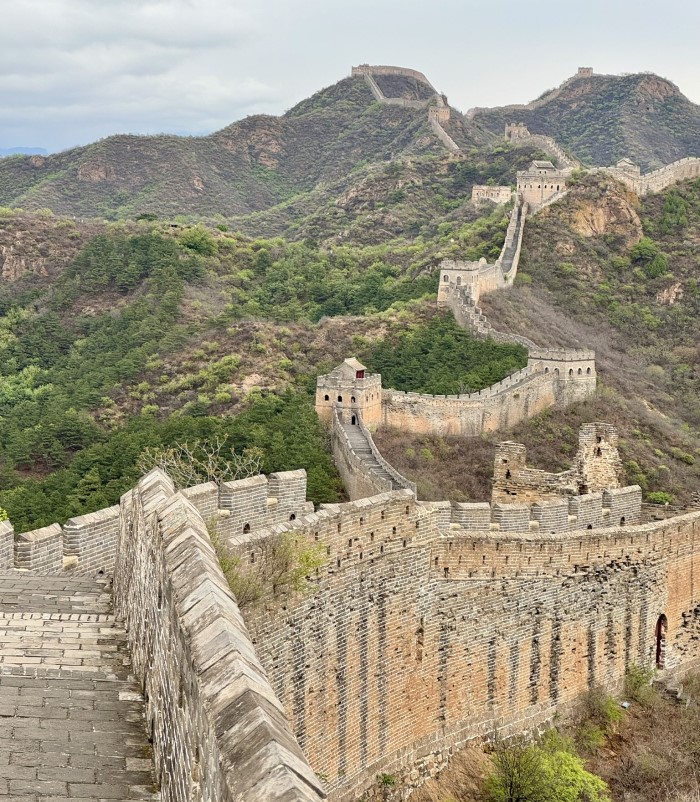
> Where to stay in Jinshanling?
Jinshanling Great Wall Hotel, located right next to the entrance to the Great Wall and the cable car station (about a 5-minute walk), is a great choice. We paid just under $100 for a beautiful, modern, clean and spacious double room with breakfast, which was the most affordable option. I booked the room through Trip.com. The location of the hotel is fantastic and the value for money is excellent. I highly recommend it!
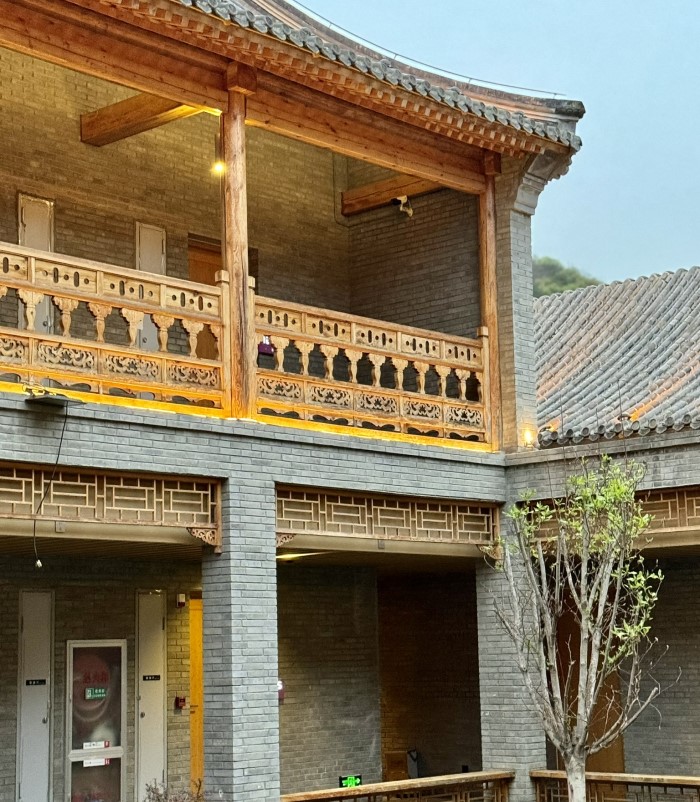
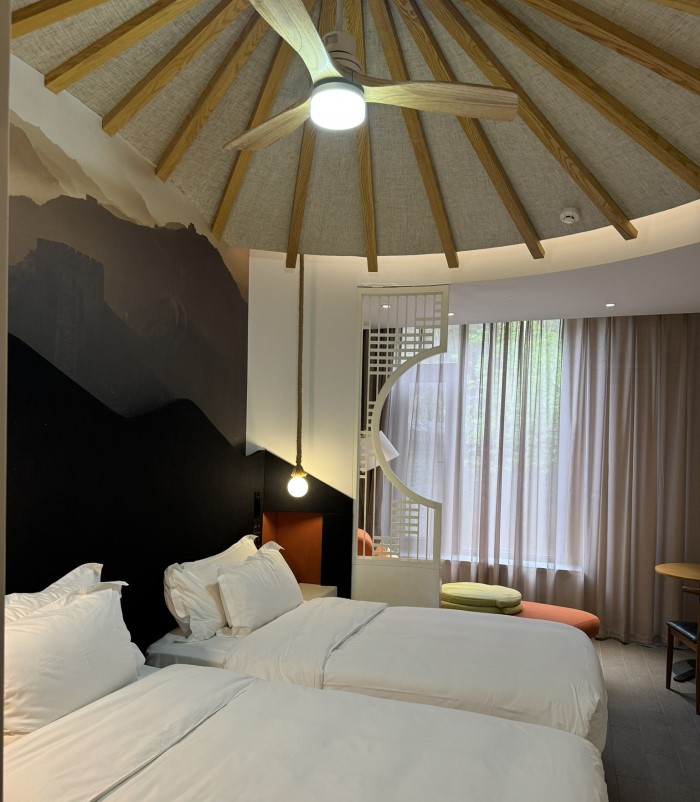
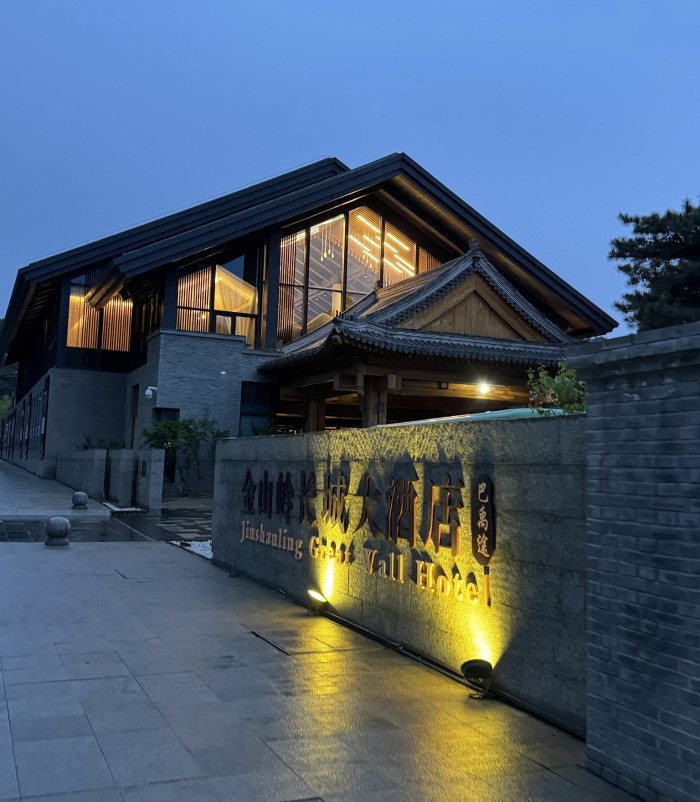
> The Great Wall: how crowded it really is?
The best months to hike the Great Wall are March to May and September to November. We hiked the Great Wall in late April. While walking from Gubeikou to Jinshanling on Sunday and from Jinshanling to Simatai West on Monday, we encountered almost no one along the way. The view of the wall and mountains was endless, stretching out in front of our eyes. The weather wasn’t ideal—a light drizzle the first day and overcast the second, which might explain the low number of tourists.
not as crowded as some say...
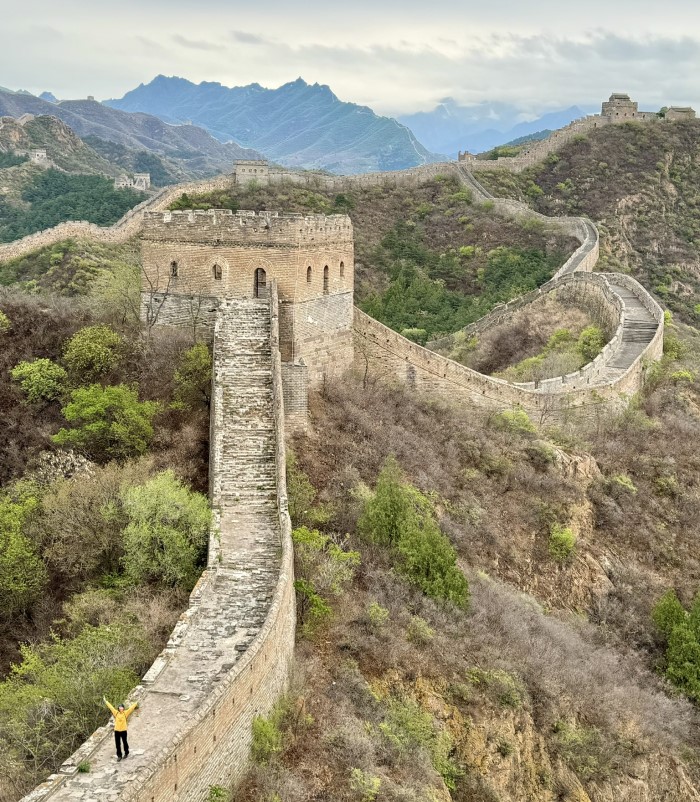
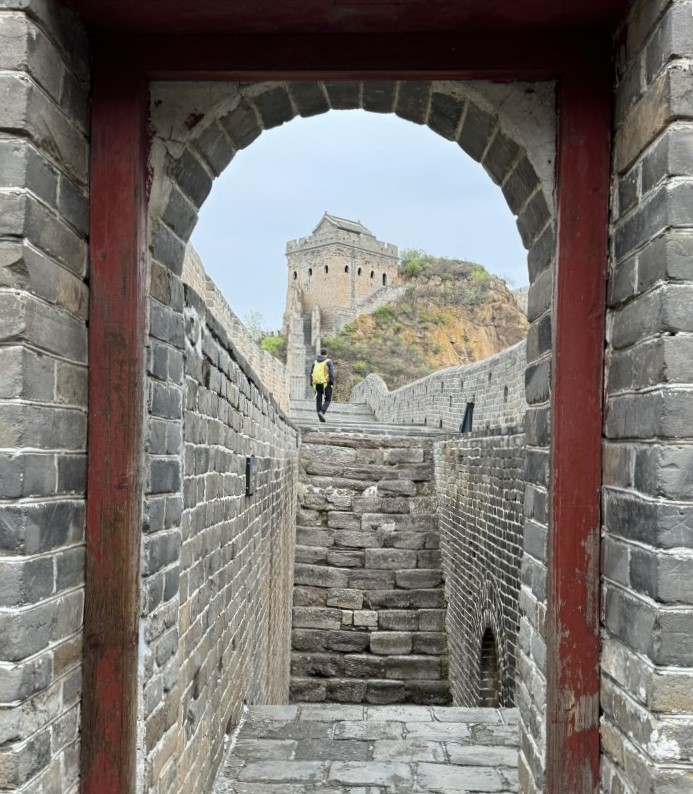
To tell the truth, I don’t think this part of the Great Wall is ever too crowded. Large, noisy tour groups, and those who just want to catch a glimpse of the Great Wall rather than experience it, tend to head to Badaling or Mutianyu, not Jinshanling.
> A detailed itinerary of a 2-day hike on the Great Wall of China
DAY 1: Beijing > Gubeikou > Jinshanling
Walking distance: 8.5 km on the Great Wall + 1.5 km stairs down + a short asphalt path to the Jinshanling Hotel.
06:56 – 09:23: Travel by train from Beijing North to Gubeikou.
09:23 – 11:00: Found a car with a driver at the Gubeikou station, drove to the Jinshanling Hotel to leave our luggage at the hotel. After checking in (we were allowed to do it at 10 AM – yay!) and preparing our daypacks for the hike, we returned to Gubeikou with the same driver. On the way we stopped in town to buy food, and then drove to the Great Wall in Gubeikou.
Tips: If you left your luggage in Beijing or are travelling light, you can go directly from Gubeikou train station to the Great Wall. I suggest stocking up on food in Beijing, as there is nothing around the Great Wall. We bought a can of sardines in tomato sauce and bread from a shop in the town of Gubeikou, where we stopped along the way.
Stock up on food in Beijing as there is not much in Gubeikou
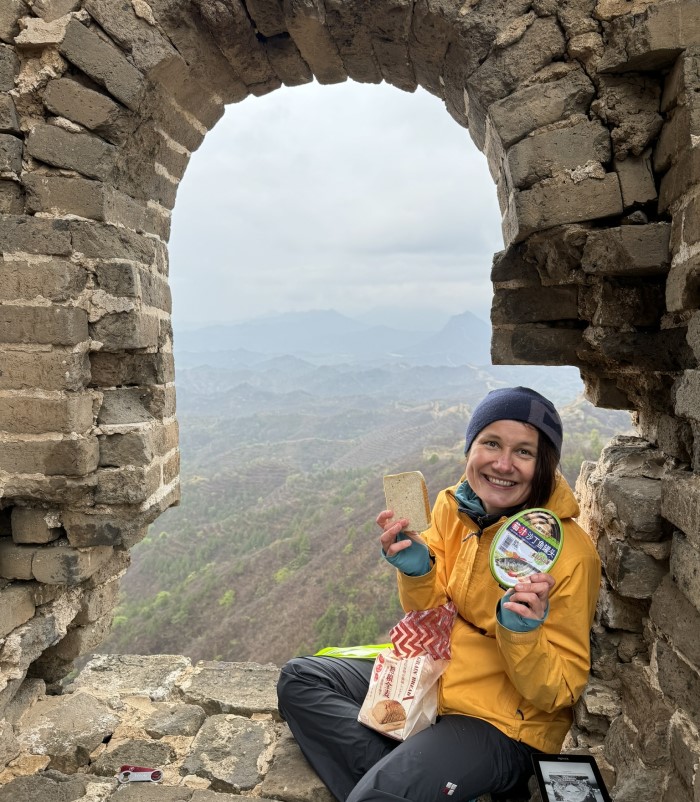

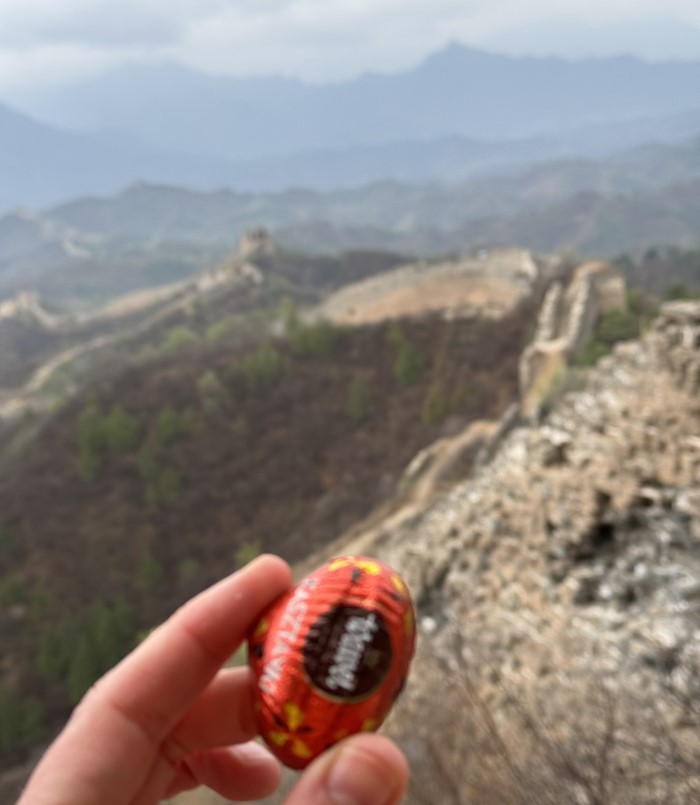
11:00-17:00: 6-hour hike along the Great Wall from Gubeikou to Jinshanling with plenty of breaks for snacks and photos. At one point you have to get off the wall and head onto a path to avoid entering the military zone. But the trail is well-marked and quite pretty, so don’t worry too much about it.
It's impossible to miss the white sign marking the military zone.
The alternative path goes through the forest first.
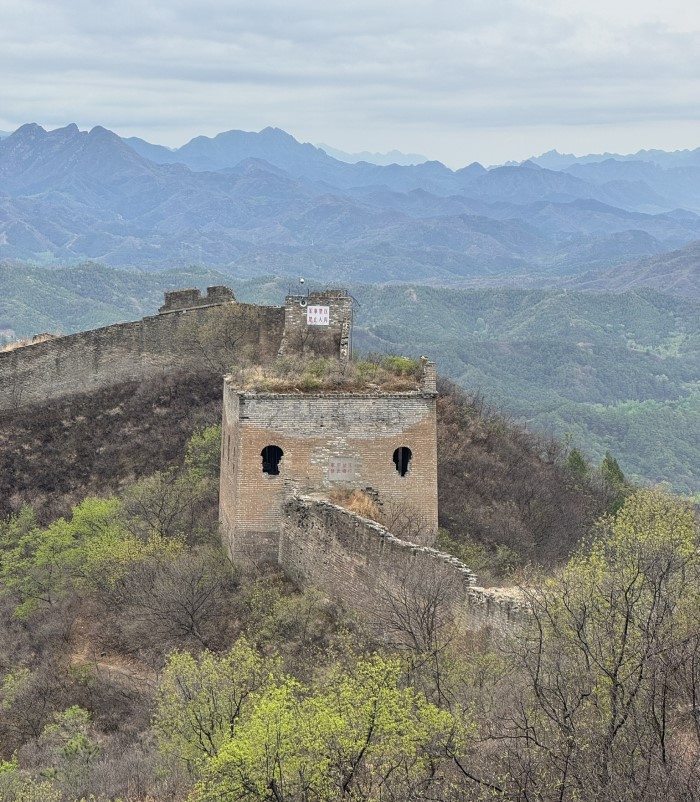
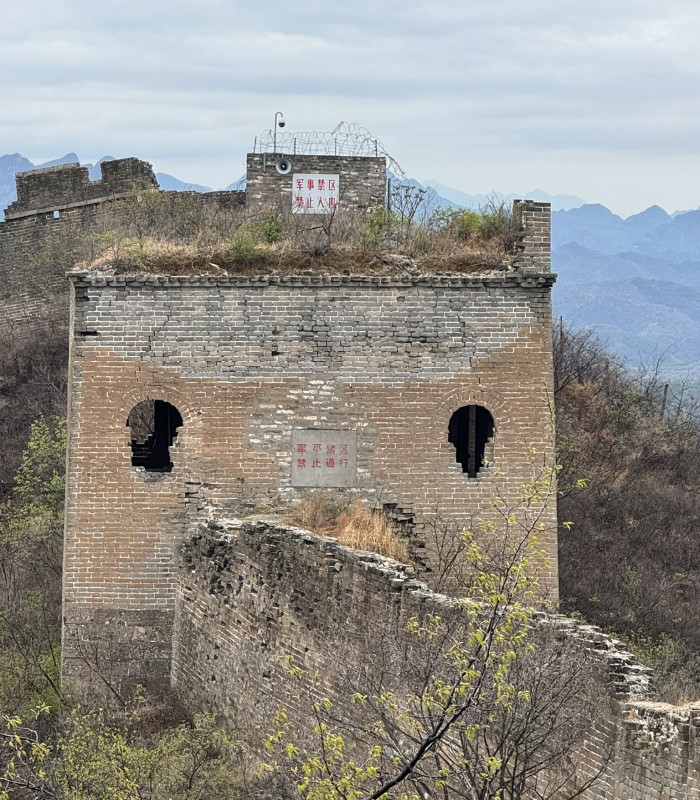
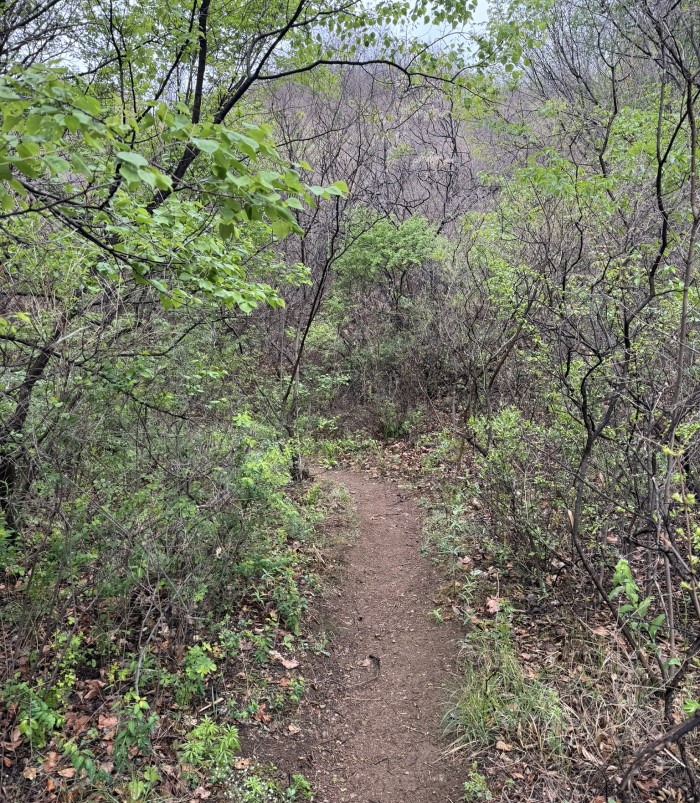
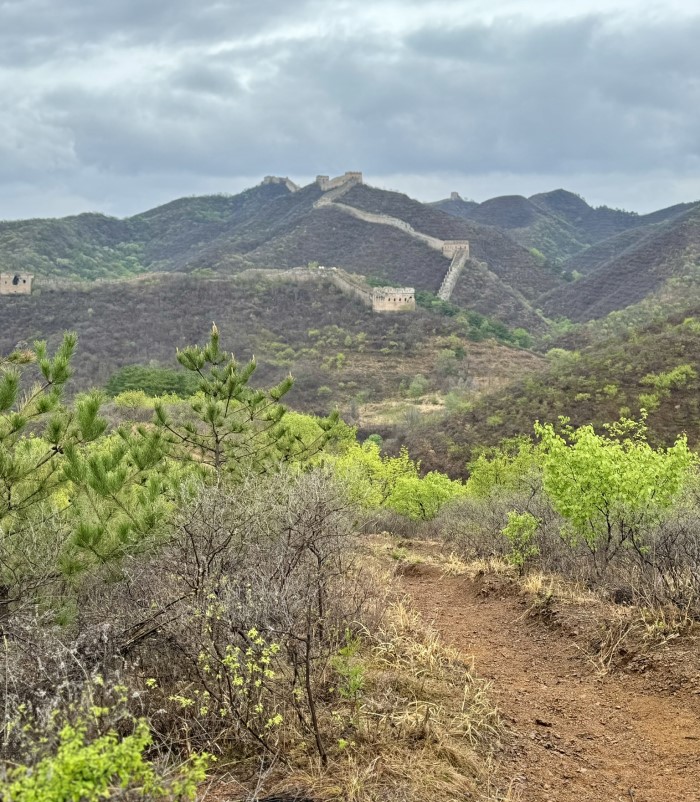
The First part of the day - hiking the unrestored Gubeikou
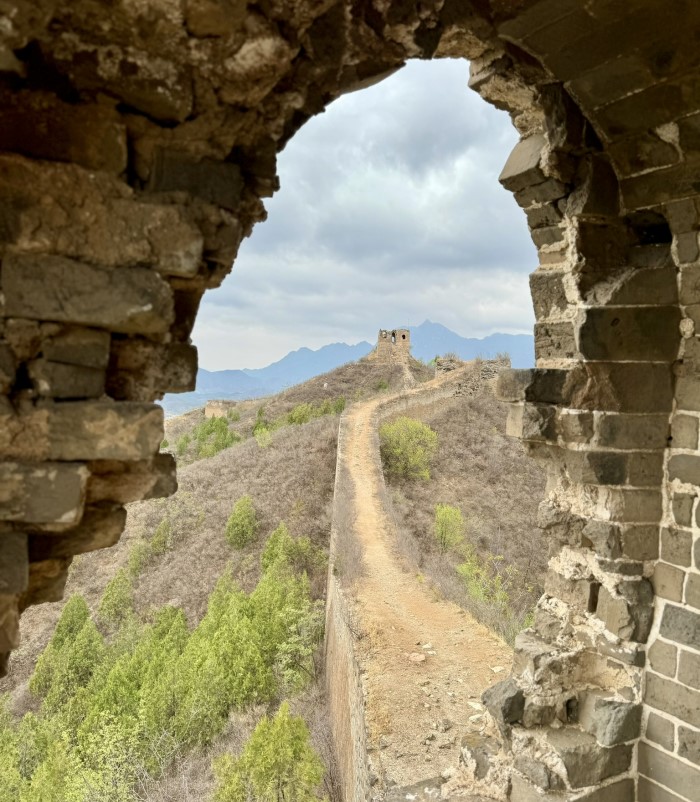
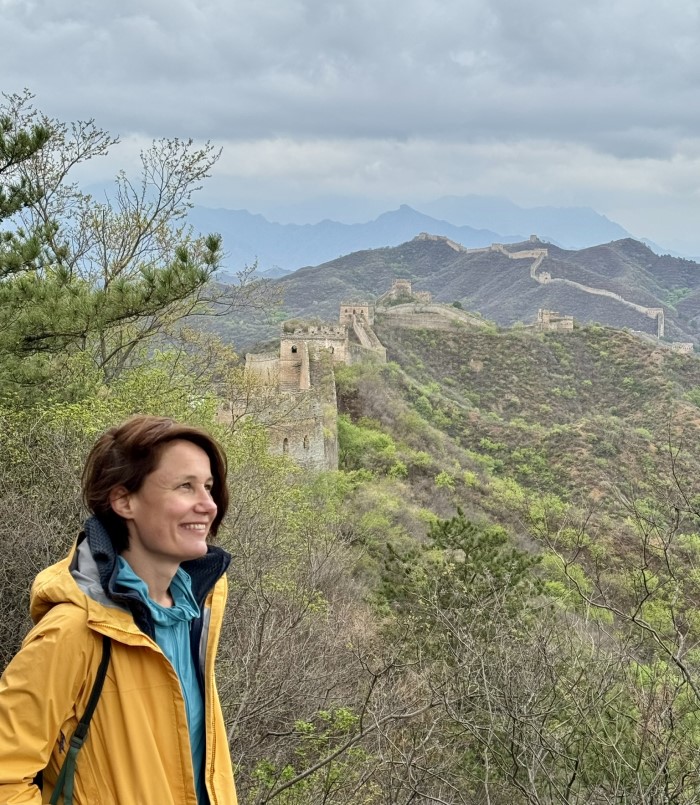

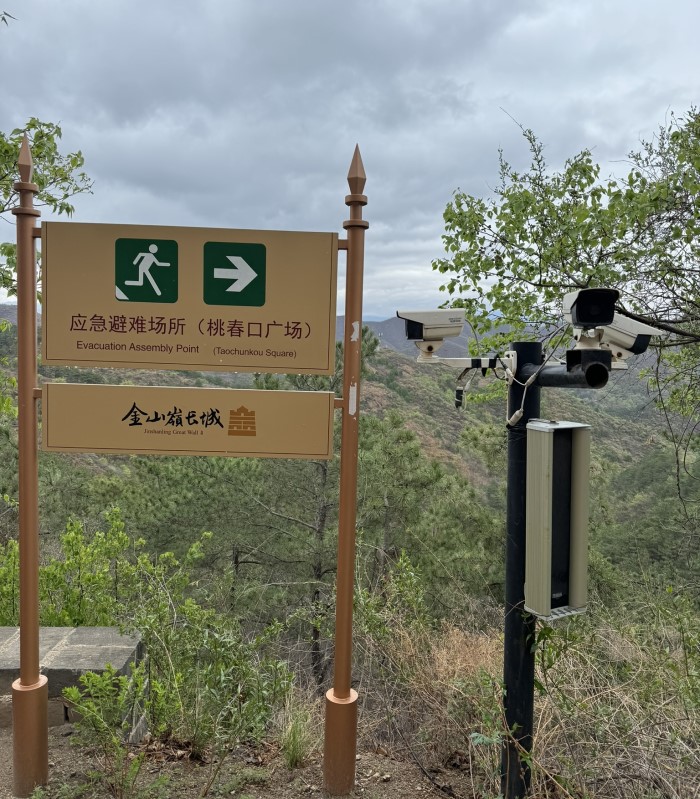
Welcome to Jinshanling and the weather got a bit better!
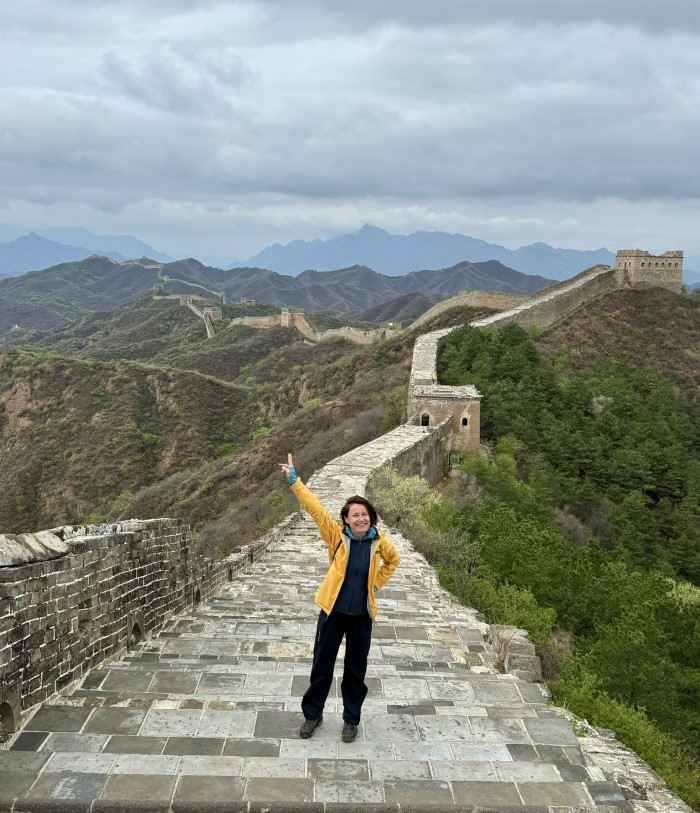
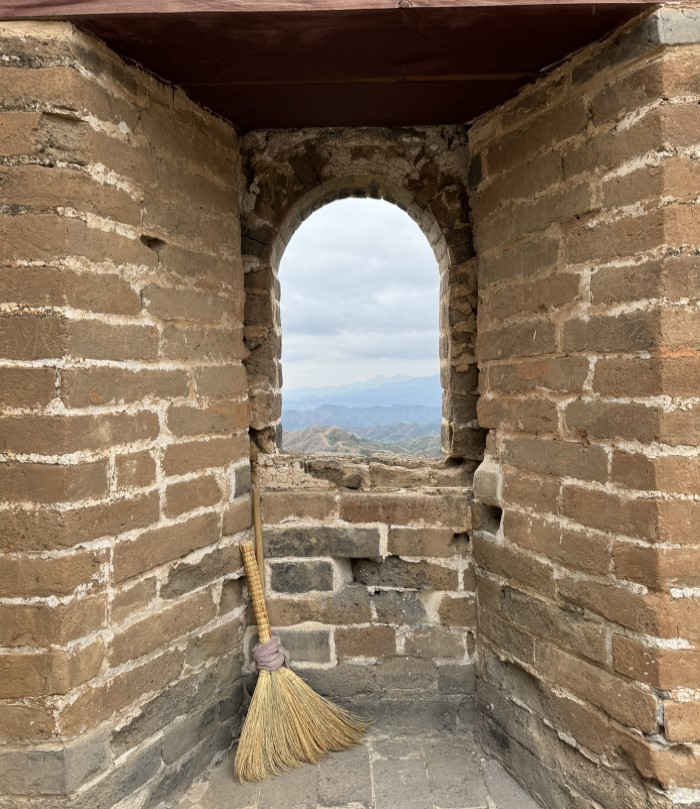
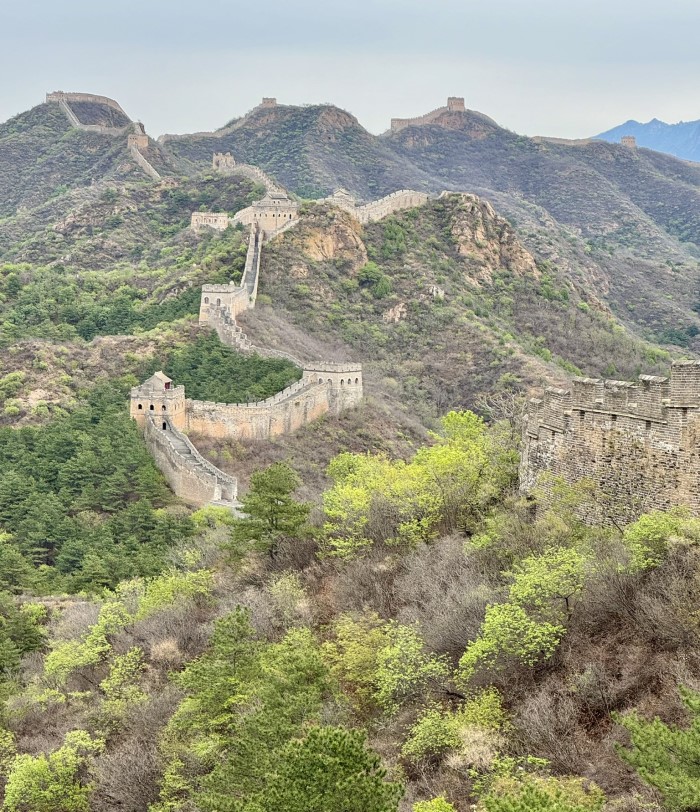
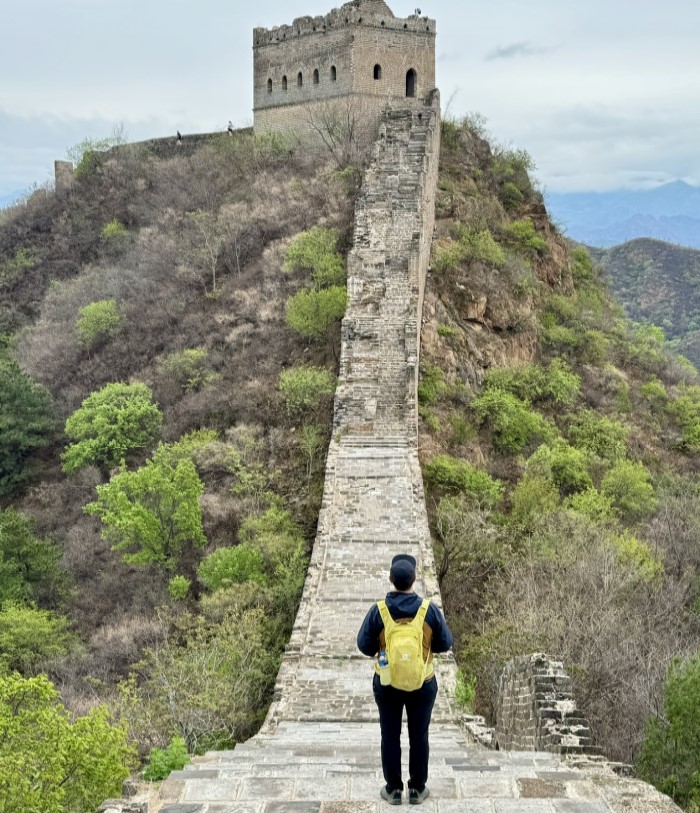
Leaving the Great Wall behind and descending to the hotel.
The signs & maps are clear, so it is really difficult to get lost.
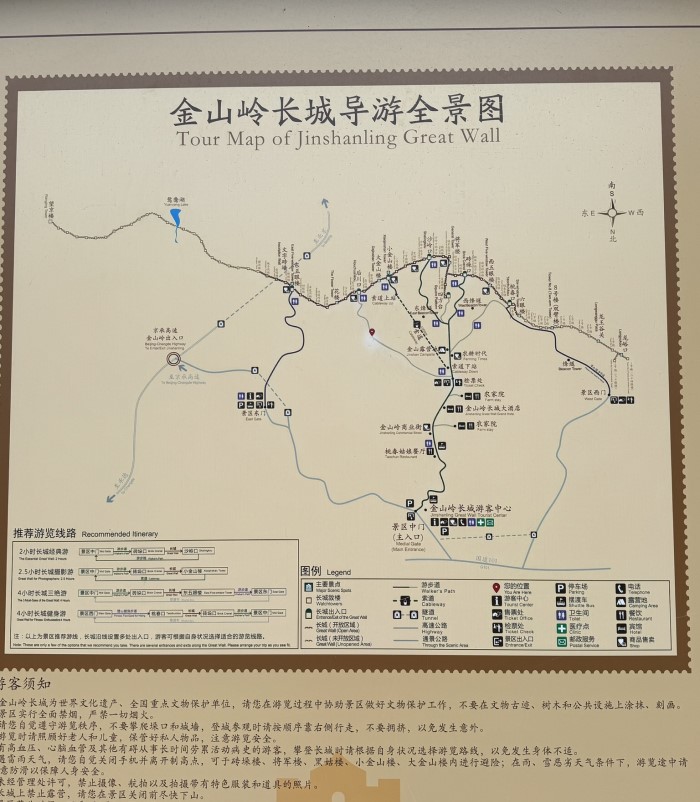
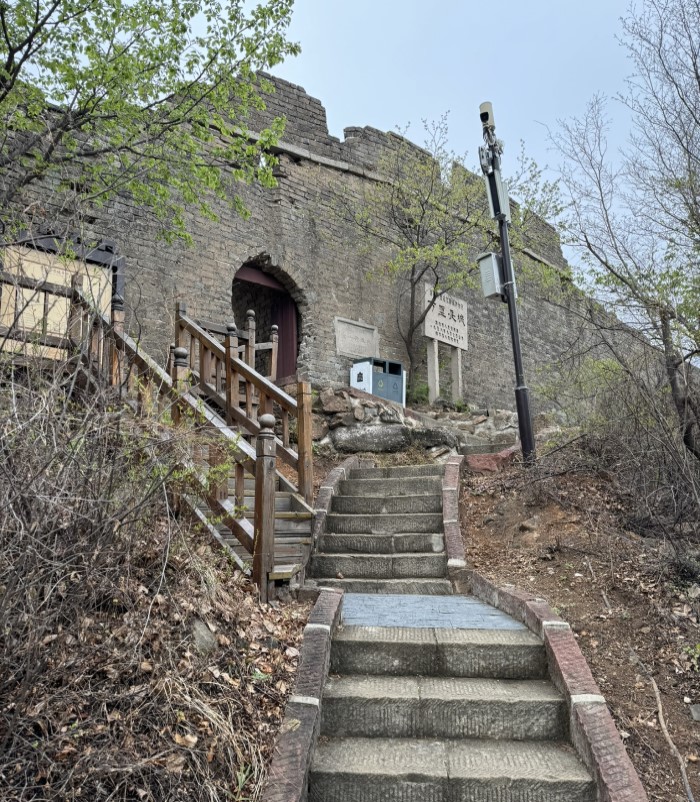
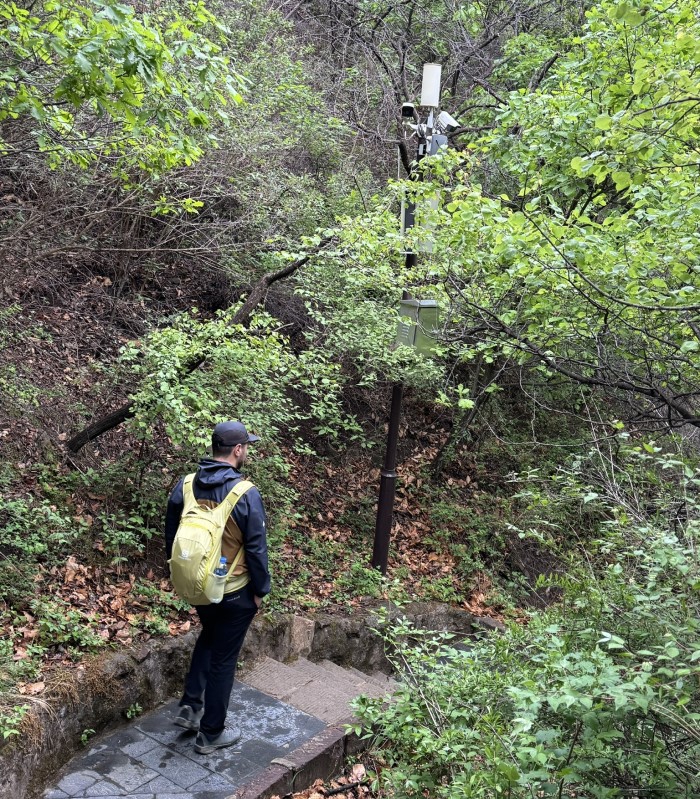
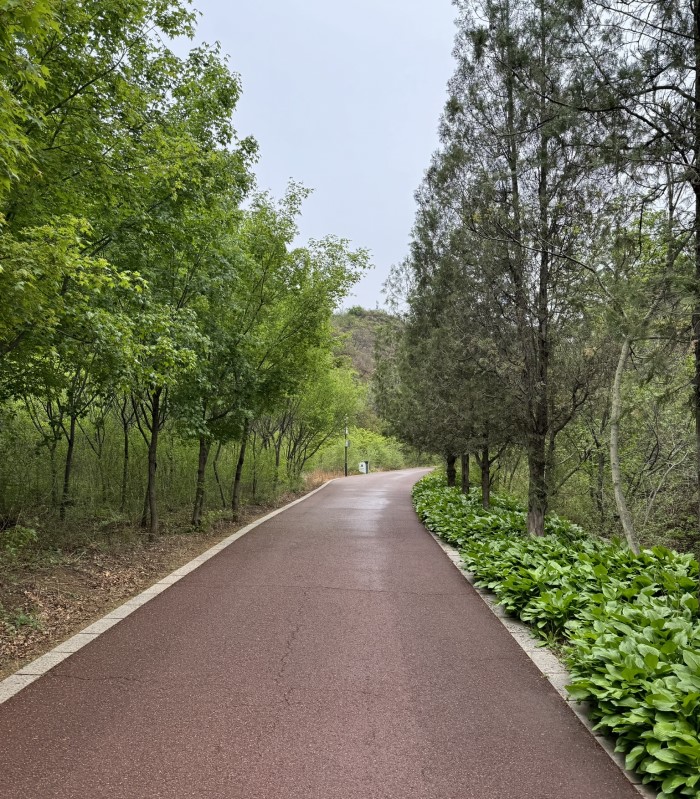
19:00: Dinner at the hotel. There are no restaurants near the hotel except for a small souvenir shop that also serves simple noodle dishes. We decided to eat at the hotel. The variety of food on the hotel menu is huge, the portions are large, and the quality of the food is excellent. We couldn’t eat it all, so we asked for takeaway boxes and ate the leftovers for lunch the next day.
Remember the word “tapao” which means “takeaway” in Chinese. If you say it while pointing at the food, the waiter will bring you a plastic box.
More about this Great Wall section: Travel China Guide: Gubeikou to Jinshanling Great Wall Hiking
DAY 2: Jinshanling > Jinshanling East / Simatai West > Jinshanling > Beijing
9:30-12:30: a short cable car ride followed by a 3-hour easy hiking
Taking the cable car up the Great Wall at Jinshanling will save you some energy and precious time for a beautiful hike.
JINSHANLING CABLE CAR AND MY NEW COLOUR-MATCHING FRIEND
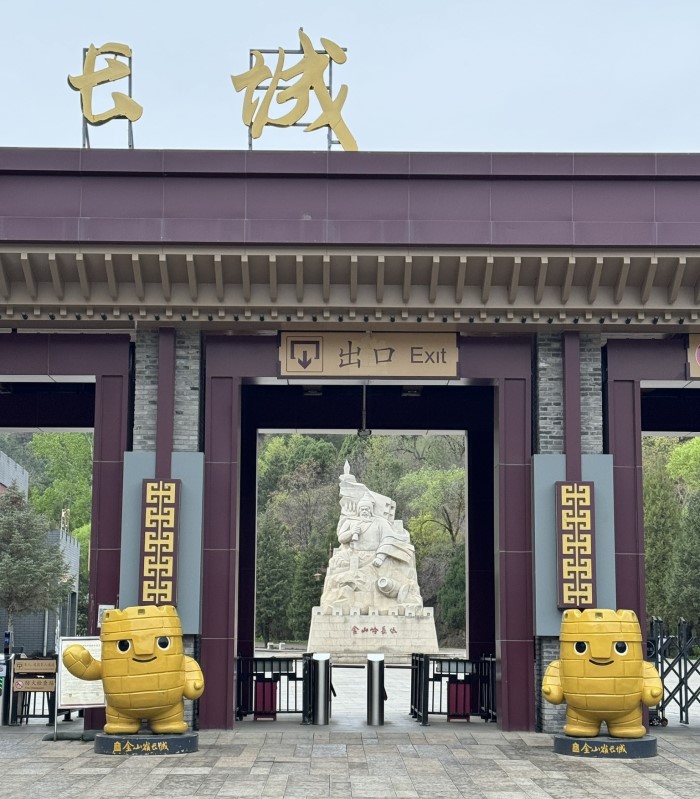
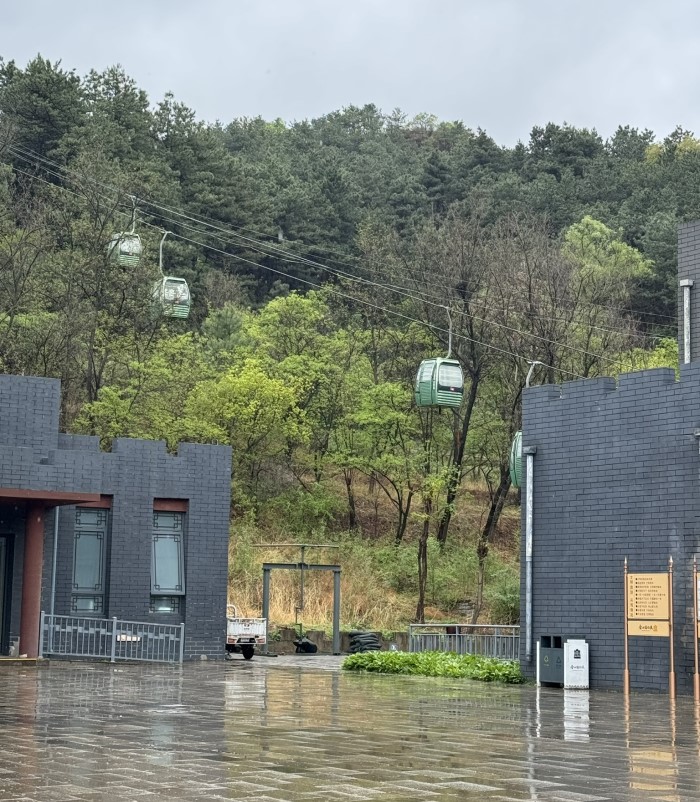
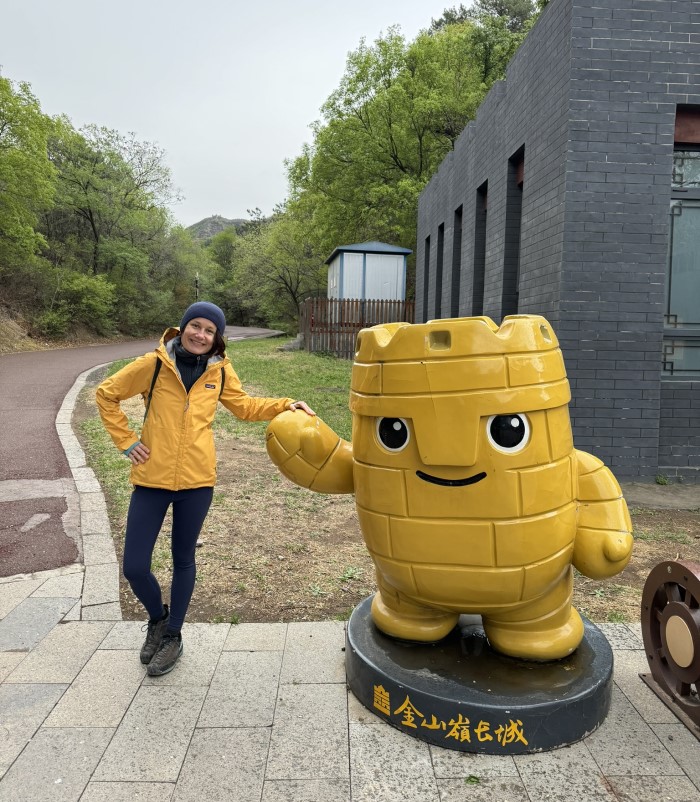
Hiking from the upper cable car station to Jinshanling East/Simatai West and back. Walk down to the hotel the same path as the day before.
Some parts were quite steep, so we were glad to tackle them well-rested on day 2!
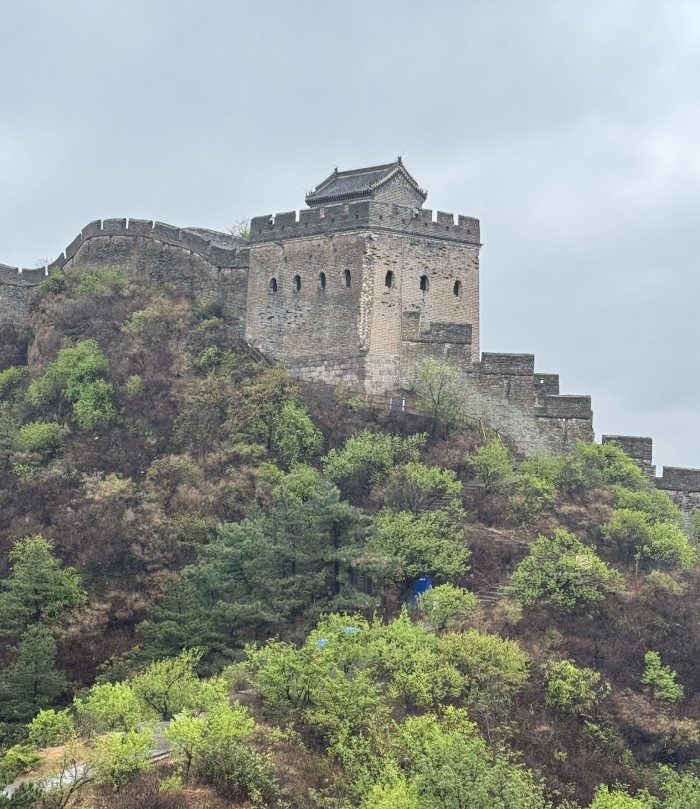
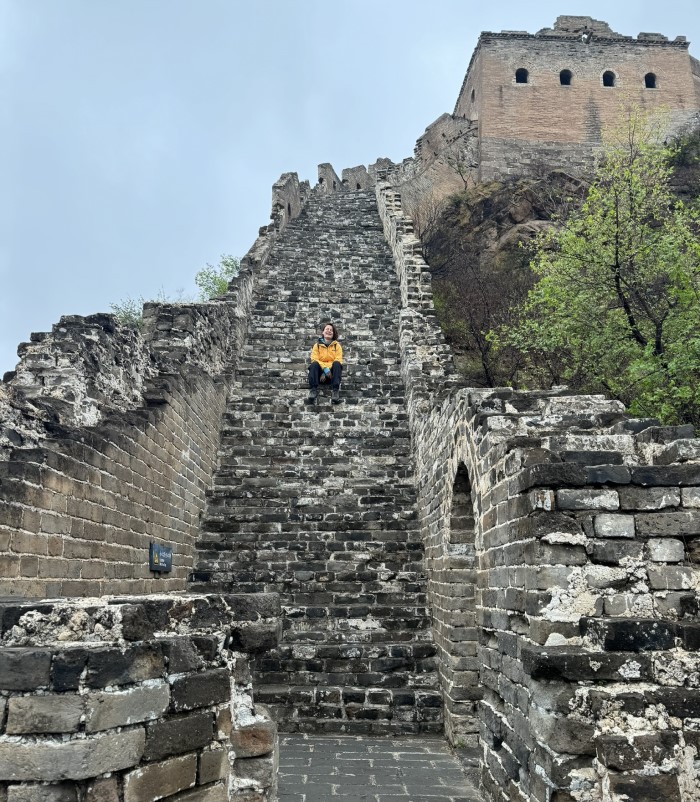
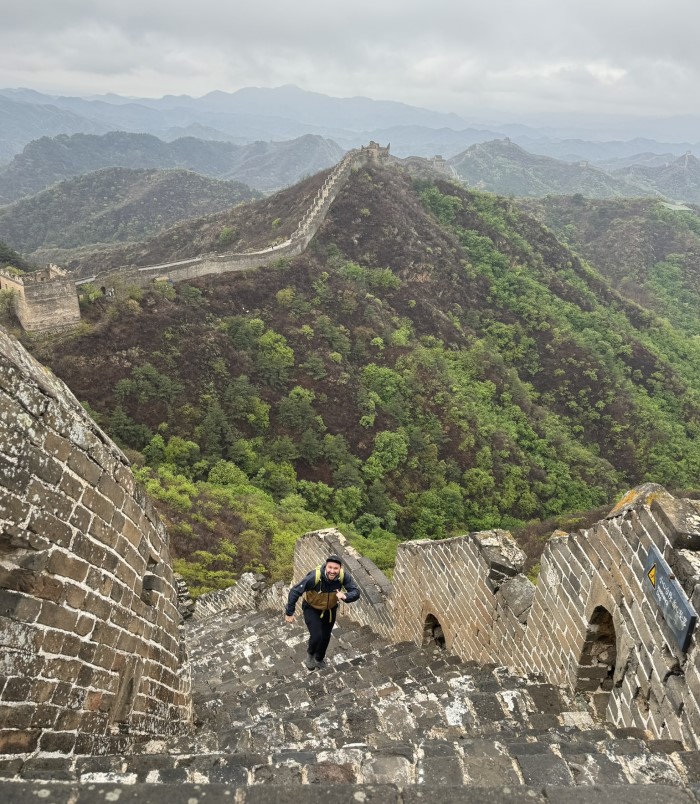
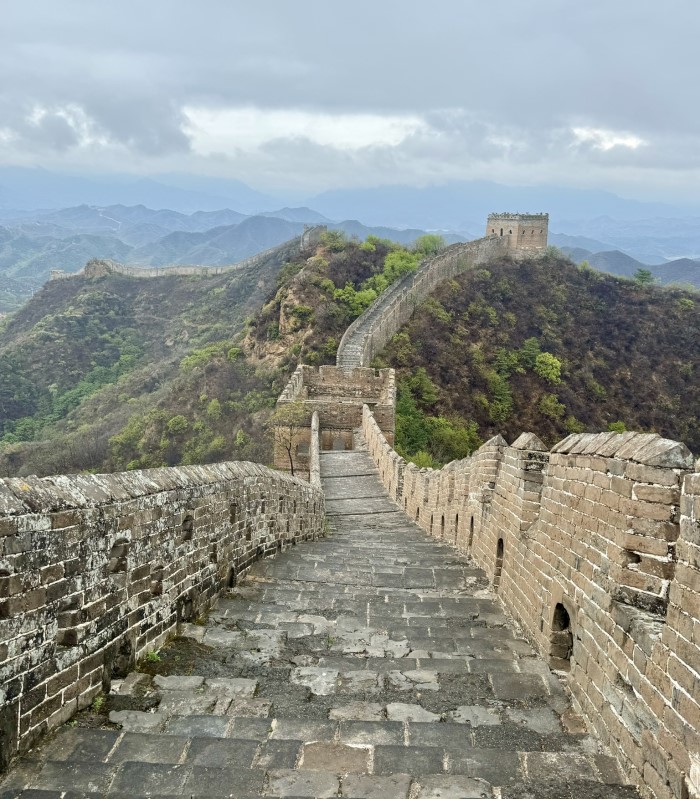
This lovely lady ran a tiny shop in the last watchtower we climbed to.
Of course, we couldn’t refuse the cold beer she offered! 🙂
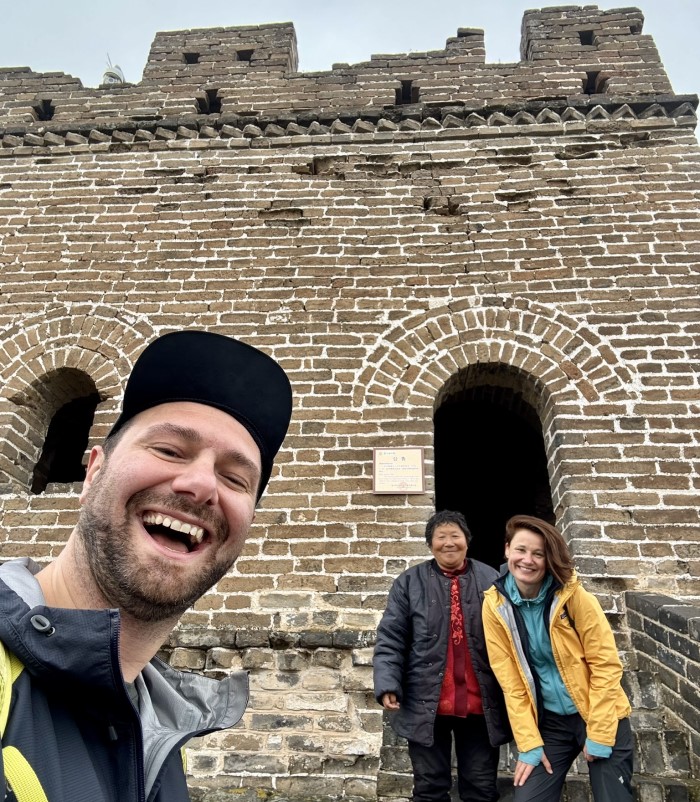

After your hiking have a leisurely lunch and relax before heading back to Beijing or alternatively take a taxi to Simatai to visit the eastern part of the Great Wall (Simatai East) and the Gubei Water Town.
17:20-19:52: Travel by train from Gubeikou to Beijing North.
Suggested 2-day route
Gubeikou — walking → Jinshanling — walking → Jinshanling East = Simatai West — only taxi, because you can’t walk this part → Simatai East — taxi back to the train station → Gubeikou
> Travelling from Beijing to Gubeikou
There are three options for getting to the Great Wall in Gubeikou on your own. You can take:
- a car/taxi (the most expensive option),
- a bus (the slowest option at 3.5-4 hours) or,
- a train (cheap, easy and relatively fast). We opted for the train, which turned out to be a great solution.
Trains from Beijing to Gubeikou
There are only two trains a day from Beijing to Gubeikou. If you take a morning train, you can do a day hike and return to Beijing in the evening. This is a good option if you are short on time or didn’t manage to book a room at the Jinshanling Hotel. Otherwise, consider a two-day trip. The Great Wall is truly magnificent and deserves more time!
Trains from Beijing North to Gubeikou:
Train No. | Beijing North Departure | Gubeikou Arrival | Fare |
S501 | 06:56 | 09:23 | CNY 12/ USD 2 |
S503 | 14:20 | 16:50 |
Trains from Gubeikou to Beijing North:
Train No. | Gubeikou Departure | Beijing North Arrival | Fare |
S502 | 10:00 | 12:28 | CNY 12/ USD 2 |
S504 | 17:20 | 19:52 |
I booked our train tickets to Gubeikou on the Trip.com website and paid less than 2 USD for a very comfortable 2.5-hour train ride (on-way ticket). You don’t even need to pick up a paper ticket or print out the email; just show your passport at the train station entrance. Once your passport is scanned and checked, you are allowed into the station and onto the platform. Finding the platform was also very easy. The train was new, clean and arrived on time. The whole trip went very smoothly; it couldn’t have been better. You really don’t need a guide to go to the Great Wall.
Both Beijing North & Gubeikou Stations were nicer and Easier to navigate than expected. The train itself was so comfy and clean!
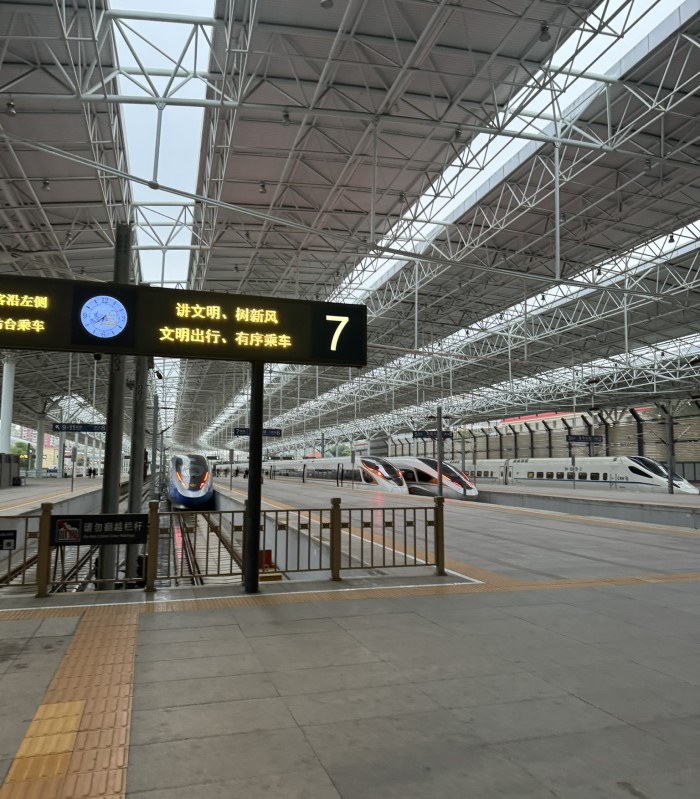

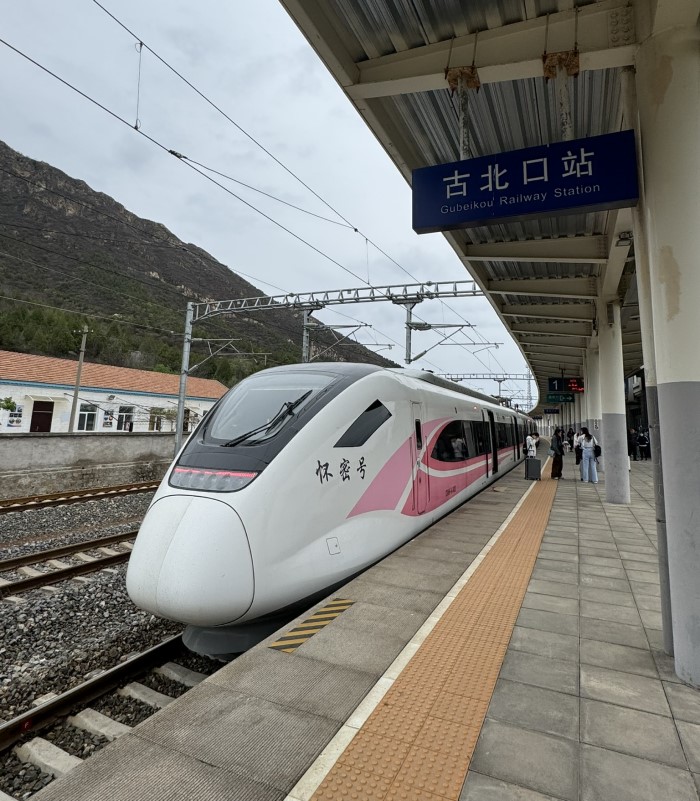
Train tickets sale begins 2 weeks before the date of departure. You can reserve tickets before. Cancellation is free before tickets are issued. Successfully reserving tickets does not mean you have successfully purchased the tickets. If we are unable to purchase tickets for you, you will be fully refunded.
Source: China train booking on Trip.com
> How to get to Gubeikou Great Wall (Panlongshan)?
Unless you want to walk over 6 km, which is a bit pointless, the easiest way to reach Gubeikou Great Wall from the train station is by taxi. When we arrived, both regular taxis and DIDI (the Chinese equivalent of UBER) were not available, but it turned out not to be a big deal. As soon as we got off the train and exited the station, several drivers approached us asking where we wanted to go. Both drivers we spoke to quoted us the same price of 80 CNY (about 11 USD) for a 15-minute ride.
I am pretty sure there will always be drivers at the Gubeikou train station looking to make some money. Travelling around Asia is easy because there’s always someone willing to provide a service or give you a lift, and if not, at least they know someone who can. Always ask at your hotel, train station, or wherever you are. Even in China, where no one speaks English, it’s easy—just use an online translator on your phone. Prices are usually very reasonable by Western standards, and it’s a safe region, so you can get in a car with a stranger. I’d probably hesitate to do this in South America, but I’ve done it many times in China and Southeast Asia over the past 10 years of travelling, and nothing bad has ever happened to me.
Considering that we paid less than 2 USD for train tickets, the total cost of the ride to the Great Wall for two people was 15 USD. Not bad, right?! In Gubeikou, tell the driver “Panlongshan” because that’s the section of the Great Wall you want to go to.
Alternatively, you can take a bus from the train station to the town of Gubeikou, where you can start walking. Download the Organic Maps app for detailed offline navigation so you always know where you are. As a side note, this app has worked great in all the countries I’ve travelled to, not just China.
Signs marking the start of the Great Wall in Panlongshan - Gubeikou
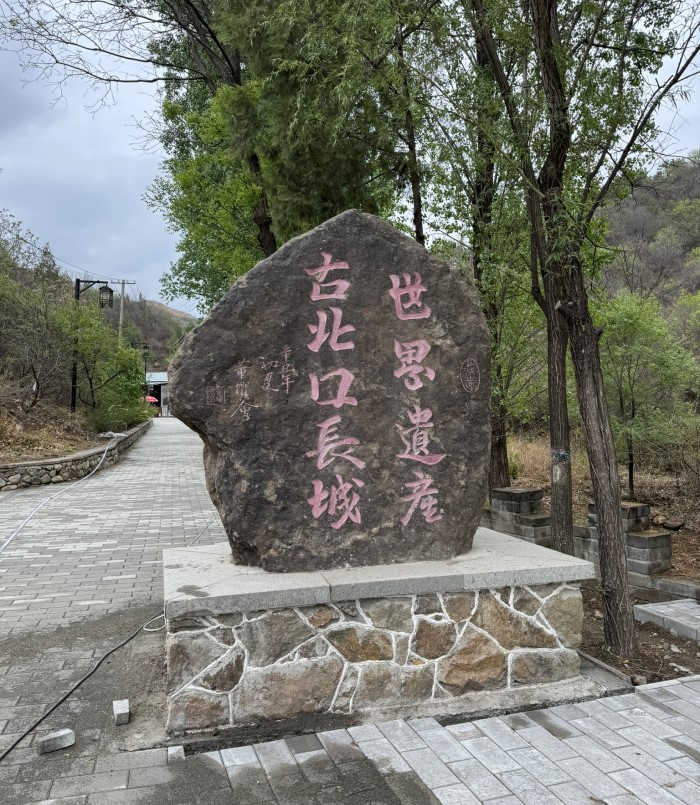
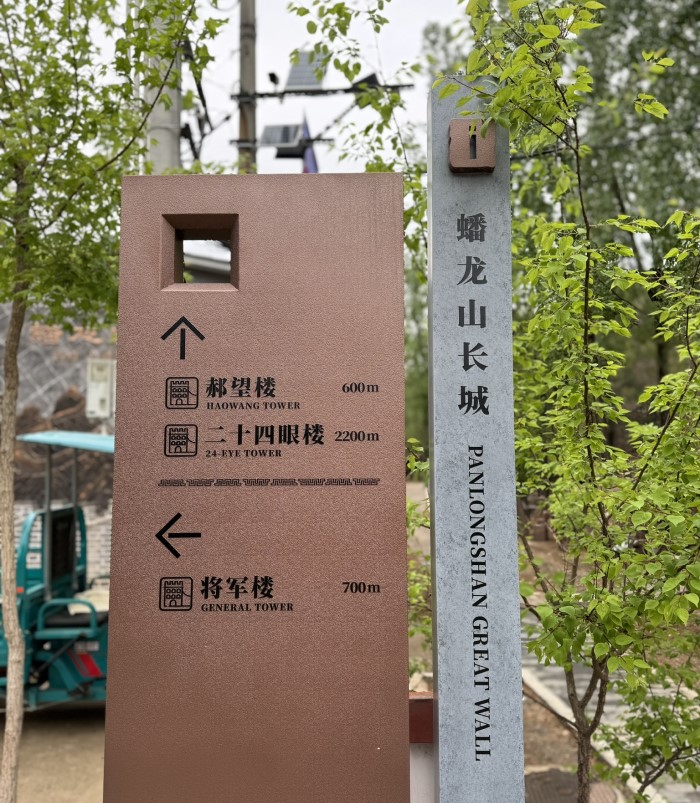
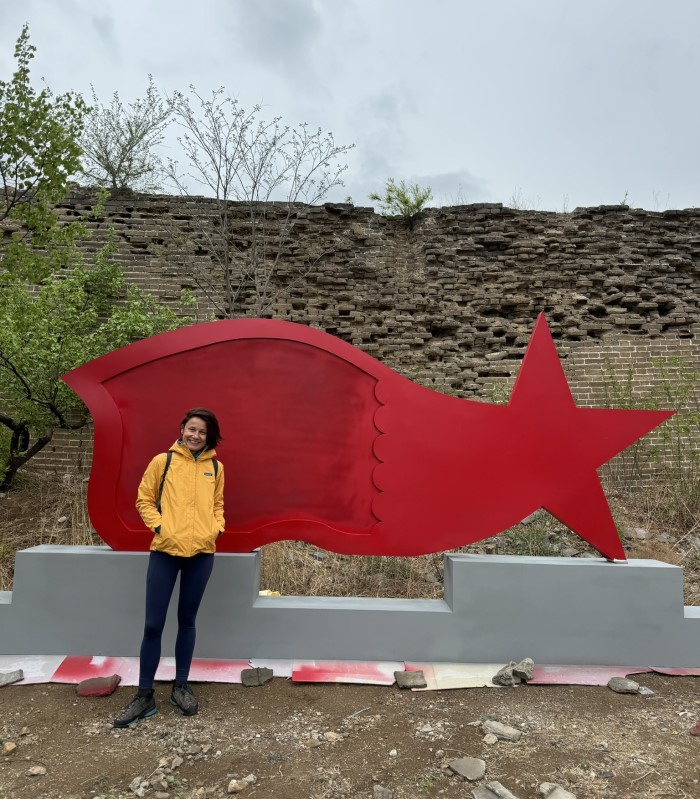
Gubeikou is one of the oldest and most historically significant sections of the Great Wall It is also one of the most war-torn passes on the Great Wall. According to records, there were as many as 130 battles related to Gubeikou in history! Originally built during the Northern Qi Dynasty (550-577 AD), it later expanded during the Ming Dynasty. Unlike more heavily restored sections like Badaling or Mutianyu, Gubeikou remains largely unrestored.
> Jinshanling Great Wall: opening hours & admission fee
Opening Hours
- April to October: 6:00 – 18:00
- November to March: 6:00 – 17:30
Admission Fee
- April to October: CNY 65
- November to March: CNY 55
- Free for children under 1.2 metres (3.9 feet).
Apparently you don’t need to buy tickets for the second day of the hike, which we didn’t know about, and you can use the same tickets on both days.
Jinshanling Great Wall is free of charge for the second entry, which means you can enter the scenic area twice from the time when you buy the tickets to the closing time the next day. If you want a second entry, please explain in advance when purchasing tickets and buy the fingerprint ticket. Register your fingerprint at the ticket gate and verify the fingerprint when entering for the second time.
Source: Travel China Guide: Jinshanling Great Wall
The entrance fee to Gubeikou is lower, but I can’t recall how much we paid – something between 30 – 45 CNY per person.
> What to do with luggage when hiking the Great Wall of China?
The fear of not finding a taxi at Gubeikou train station and the problem of what to do with the luggage during the Great Wall hike (we did not return to Beijing) were my biggest worries when planning the trip.
As for luggage, you have three options:
- Leave it at your hotel in Beijing if you plan to return to the city.
- Store it at Beijing North train station, from where trains to Gubeikou depart. The luggage storage is located south of the ticket office or near the waiting room on the 1st floor. The fee is CNY 20 per piece of luggage per day. I did not use this option, so I do not know how it works.
More information: Travel China Guide – Beijing North Station
- Leave your luggage at your hotel in Jinshanling and take a taxi back to Gubeikou Great Wall, which is what we did.
- If you’re travelling light, just bring your backpack with you.
> The Cost of Hiking the Great Wall: Self-Guided vs. Organized Tours
At the time of writing, a 9-hour tour from Beijing to Jinshanling East (Simatai West) on GetYourGuide.com costs almost $160 per person. This includes a 5-hour van ride, a 1-hour lunch break, and only 3 hours of hiking.
In contrast, my plan, which includes 2 full days of hiking the Great Wall and an overnight stay in a very good hotel, costs around $130 for 2 people! The costs are as follows:
- Return train ticket for 2 people: $8,
- Taxi to/from Gubeikou: $30,
- Night in a hotel in Jinshanling: $94.
Our costs were a bit higher because we wanted to leave our bags at the hotel before going to the Great Wall, so our taxi ride was longer on Day 1. Additionally, on Day 2, we had to leave Gubeikou earlier (before the train departure) to be able to catch the evening train from Beijing to Xi’an, so we took a taxi from Jinshanling to Beijing West train station instead of taking a train. We arranged this with the same driver as the previous day.
A tiny shop & the Great Wall
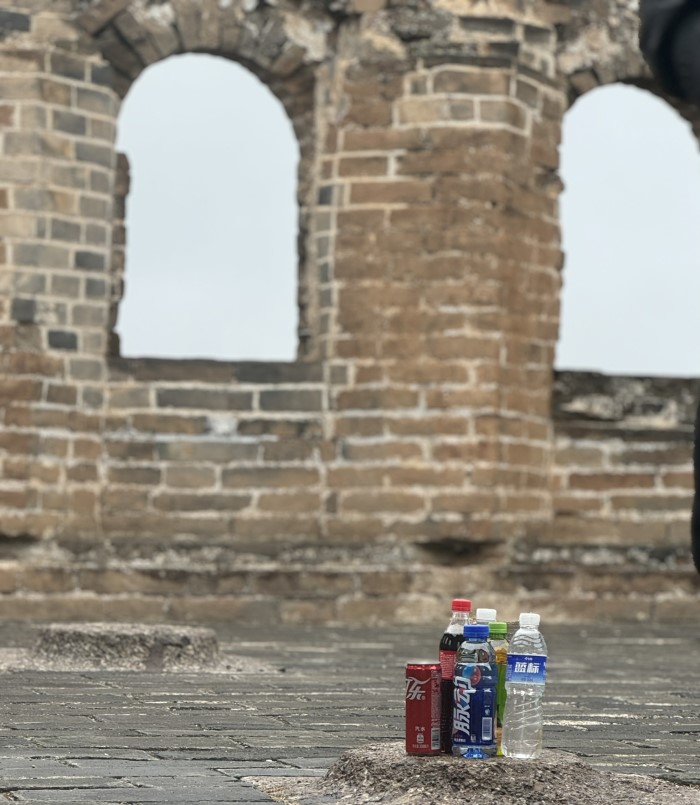
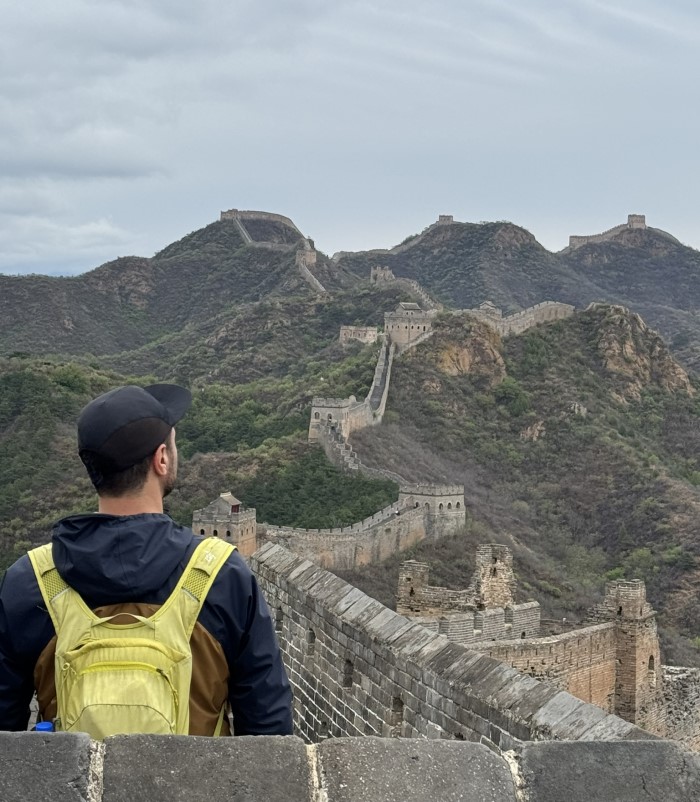
An independent hike on the Great Wall is easier than you might think!
You can easily book both train and hotel tickets on Trip.com. If you need a taxi, instead of looking for a driver at the station like we did, you can book one through the hotel. Planning a self-guided hike on the Great Wall is really very easy and affordable.
Hiking without a guide and the inevitable time constraints of travelling with an organised group gives you plenty of time to get to know the Great Wall area better and soak up its incredible magic.
A self-guided tour of the Great Wall is actually easier than you might think! Especially with my blog.. 🙂
And last but not least, who does Michael Jackson pose better 🙂
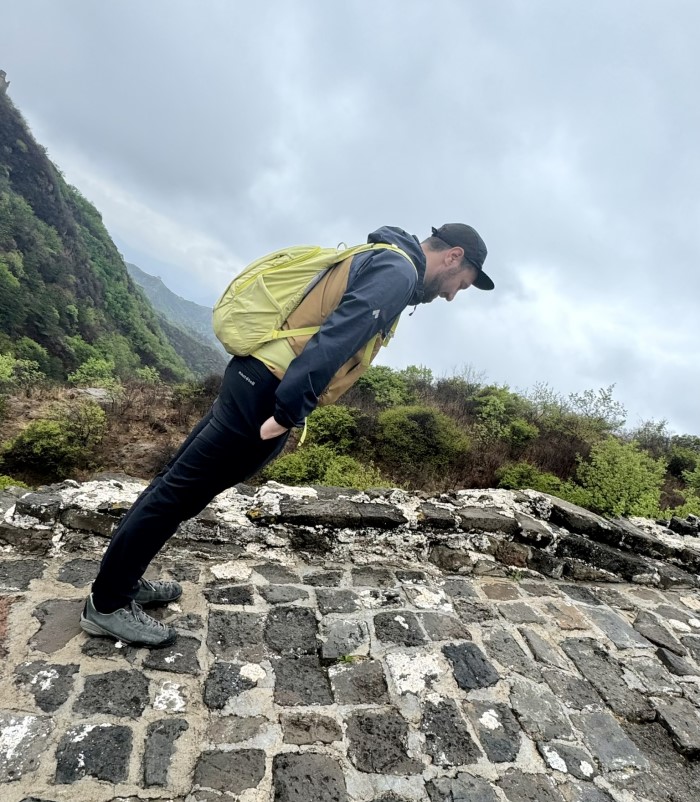
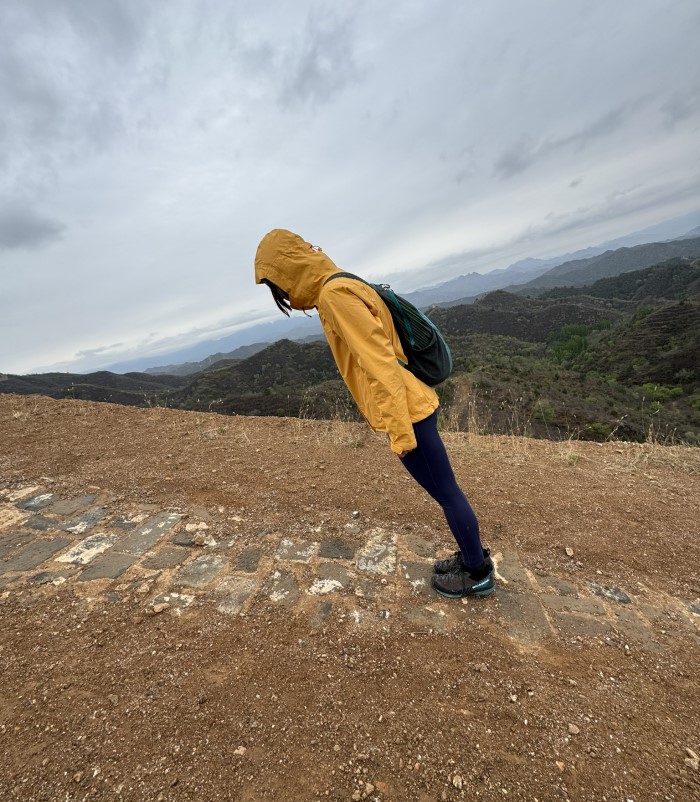


Thanks for this guide.
Oh, it’s my pleasure 🙂
Thanks for this very comprehensive guide! So useful to help us plan a trip to the Great Wall. Although you definitely got ripped off on the ‘taxi’. We didn’t pay much more than 80 yuan for a 1 hour drive to the Terracotta Warriors in Xi’an. I’d expect maybe 15 yuan or so for a 15 minute drive using Didi
Hi Linda! Thanks so much for reading my blog and leaving a comment! Getting feedback really motivates me to keep sharing my experiences.
About the taxi ride in Gubeikou… If there had been Didi taxis around, I definitely would have paid less, but since there weren’t any, I just paid what I was asked. My only other option was to walk.
I’ve had pretty cheap rides in Xi’an, Beijing, and other tourist spots. The tricky part with Gubeikou is that Didi wasn’t available when I visited in May 2024. Unfortunately (or maybe fortunately!), it’s not a super touristy area, so getting around can cost a bit more. But it’s definitely worth it!
Update after walking the wall today! There is indeed no way to avoid paying for an expensive private cab (I was too hasty to judge in my previous comment), although he did haggle down a little. We couldn’t find the bus that was supposed to go to Panlongshan. Maybe it only runs in summer?
But we had a wonderful day out regardless! It was so amazing to get to walk both restored and unrestored parts of the wall, with few people around even on a Sunday. We are fast hikers so we did the whole itinerary described here in one day (around 5 hours of walking). But boy, some of those steps are steep!!
Hey Linda! I’m so glad you enjoyed it and shared your experience from a different angle—it’s super helpful for other readers. So, first off, THANK YOU!
Not sure about the bus schedule, but from what I know it does not bring you to the entrance of the wall but to town from where you still need to walk a lot, which is not very convenient as it’s better to walk on the wall more than to the wall 😉
Great job on haggling down the price! I think I’ve been in Japan too long because I’ve completely lost my bargaining skills from my days in Southeast Asia.
Thanks for mentioning that the route is doable in one day—that’s such a great point! And yeah, those stairs are really steep, especially at the end!!!
Thank you so much for this guide ! It’s very detailed and your pictures are beautiful. I will be trying this itinerary out in December and am a bit worried that the weather (rain, potential snow, wind…) may make the hike a bit more difficult than planned.
Hi Amelie! Thanks for your comment and for reading my blog! Don’t worry too much about things you can’t control. Hiking is always at the mercy of the weather, but I hope it works out for you. The Great Wall is mesmerizing, so even if the weather isn’t perfect, I’m sure you’ll love it! Wishing you lots of sunshine!
This is so informative, thank you so much for taking the time to put it together! I will be using this religiously on our visit and I’ll let you know how it goes!
ahhhhhhh thank you so much! It always makes me so happy to receive good feedback. I particularly like the word “religiously” 😉 Enjoy the beauty of the Great Wall & the whole hiking experience!
Hi Beti, I’m going at the end of March and definitely plan to follow your steps.
I have 12 days for hiking the wall, do you recommend any other sections?
I am considering the wall that goes south of Beijing ( Nianziguan I believe), and then the Shanghai pass where the wall meets the ocean.
Any suggestions for alternate places to visit?
I’ll be traveling alone, so don’t need to take many unnecessary risks
Thanks again,
Tony from Texas
Hi Tony!
First of all, thank you for your message. Knowing that someone is following in my footsteps always makes me so happy. The whole point of my writing is to help others travel independently.
But let’s get to the point. I would love to advise you on other sections of the Great Wall, but unfortunately, everything I know is already shared in my article. Hopefully, one day I will return to the Great Wall and explore more of it.
From my observations and experience, China is an incredibly safe country for solo travelers, so please don’t worry too much before your trip.
Good luck and happy travels!
Hello Beti,
Thank you for sharing your adventure:)
I will be travelling on my own. Is it easy to navigate the direction from Gubeikou great wall to Jinshaling Great wall. I couldn’t find any more information in rough guide. Is there a bus going from Gubeikou train station to Gubeikou great wall entrance?
Thank you in advance. Have an amazing weekend:)))))
Hi Lilian,
Thank you for your comment. You won’t find more information because it simply doesn’t exist. Most guides and blogs are very outdated—China develops too quickly. That’s why I’ve shared my experience in my blog post. There is no direct bus to the Great Wall from the station, at least there wasn’t one last year. However, you can take a bus from the train station to the town of Gubeikou, where you can start walking or take a taxi from the station—that’s what we did.
I recommend downloading the Organic Maps app for detailed offline navigation so you always know where you are. It works great in all the countries I’ve traveled to, and in China, where Google Maps isn’t really an option, it’s super useful!
Traveling in China might seem overwhelming and difficult, but it’s not—there’s always someone willing to help, and it’s a lot of fun. Good luck!
Hi Beti,
Thank you for your time and effort – greatly appreciated:))))
Have an amazing week
Best wishes,
Lilian